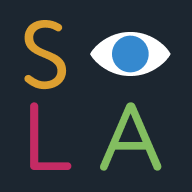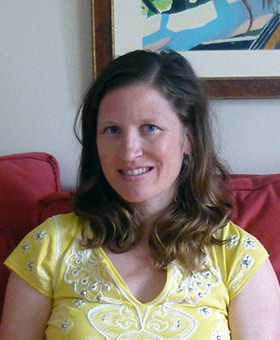 1. Can you tell us a little bit about yourself or how you got started?
1. Can you tell us a little bit about yourself or how you got started?
I grew up in Lombard, Illinois, about 20 miles outside of Chicago. My Mom studied art in college, so she got us started early with creative projects. Like a lot of parents raising kids in the 70s & early 80s, she wasn’t involved with directing us, but did give us access to a ton of art supplies— paper, markers, pens, crayons, pastels, oil paints, watercolors, wax, clay. Early on, I was obsessed with drawing and designing fashion magazines, booklets, homemade film strips, and portraits.
Years later, I studied radio/television/film at Northwestern University, where I became interested in experimental animation and video editing. After working at a Polish radio station in Chicago for a year, I moved out to Los Angeles and worked in “the Business” for awhile— art department for TV, script reading and video editing for a recording studio. In between all of those jobs, I returned to drawing and enrolled at Art Center College of Design as an illustration major. There, I became fairly obsessed with printmaking.
After 12 years in LA, I returned to Chicago. At the time, I was more motivated in a fine art direction. Out of necessity, I took a full-time office day job. I found the job to be incredibly mundane, but a foray into corporate culture felt oddly exotic. I had enough freedom to draw on the job during pockets of free time. The place was driving me crazy; drawing was a refuge from the bureaucracy. I created an entire body of work based on cubicle life. After posting the drawings for a few years on social media, the Chicago Department of Cultural Affairs and Special Events hosted a solo exhibition of my work.
I finally traded the day-job for freelance illustration, and some part-time video editing and other odd jobs. I still show and sell my fine art work, as well. In 2014, I joined ICON9 The Illustration Conference Board as the Workshop Chair. That was an incredible experience. For ICON10, I am Co-President with designer, Len Small. It’s going to be in Detroit this year, so stay tuned— I’m very excited about it!
2. What’s your daily routine look like?
I’m a night owl. I wish that I wasn’t, but when I do not have a strict schedule, I default to staying up until 2-3 am. That is my most creative time. Every day is a little different, but I get up later than the average person, do exercise, stretch, make breakfast. I tackle work, family and ICON email and phone calls in the early part of the day. After lunch, I ride my bike to my art studio, a storefront space that I share with a fellow artist, and work there. Sometimes I burn the midnight oil if I feel productive. I don’t have wifi at the studio, so it’s a good time to really focus. I take breaks to take walks, take a swim at the gym, buy food, coffee, beer, talk to studio neighbors, etc. My “good” computer is in my apartment, so if I need to do digital work, I make time to work at home. I do like having some separation between work and studio.
3. Who are you inspired by?
I derive most of inspiration from non art-related activities: reading books, taking long walks, biking, attending live music shows, salsa dancing, going places by myself and watching people. I’m inspired by the Chicago Imagists, Saul Steinberg, Takashi Murakami, Nick Cage— a lot of contemporary muralists, comic book artists and illustrators have been really exciting to me lately, as well… too many to mention.
4. Do you have a mentor or teacher that was influential on you, while you were studying in college?
I had fabulous instructors at Art Center. With art education, it takes a village. I’m going to get into trouble if I start naming them, but so many of my instructors there were thought-provoking and challenging in the best possible way. Rob Clayton, who I took a few independent studies with, was probably the most influential to me. I was always an ardent admirer of the Clayton Brothers work. Rob encouraged experimentation, keeping an open mind about artistic process and intense creativity while encouraging me to edit down my maximalistic instincts to maintain some kind of focus.
5. What has been one of your favorite projects to work on?
This past Spring, I was hired by Honeygrow, a restaurant chain based in Philly, to create mural-sized artwork for their new Chicago Fulton Market location. They perused my website and selected a few art pieces they felt the most connected to and asked me to keep it in that spirit. It was a super fun project because they gave me a lot of artistic freedom and encouraged me to include a lot of colorful creatures in the work. So, I created a nighttime cityscape inspired by the Chicago River bridges and populated with a cast of characters.
6. What medium do you work with predominately now? And do you use the digital painting medium?
I primarily work analog— pen, brush and ink, graphite, colored pencils, acrylic and gouache paints, on paper. I don’t do a lot of digital painting, except when touching up artwork, or working with animation.
7. How important is social media for an illustrator now? And how are you using it?
I think that social media is very important to illustrators today. I primary use Facebook and Instagram. Social media platforms are visual, so illustration is a natural fit and is a good way to get eyeballs in front of your work. The challenge is *how* to get followers. There is definitely an art to promotion, and I personally could use some help. To my chagrin, my PR skills are lacking. Social media has changed everything in our world, in both positive and negative ways. I came of age long before internet, email and social networking, at a time when personal promotion was considered somewhat gauche. So the pressure to adopt an advertising approach to every piece of art or life experience sometimes feels inauthentic and narcissistic. My comfort zone is with the phone turned off and just living life, but sharing artwork and ideas has been very gratifying and I’ve even gotten some very valuable art opportunities, buyers and connections through IG and FB, so I’ve kind of made peace with it for now.
8. How important is a blog/website ? How often do you update your own blog/website and what can illustrators do to get more traffic to their sites?
I believe in maintaining a website with current artwork. I was the Workshop Chair for ICON9, which involved programming over 25 workshops. Frankly, while doing research, I was frustrated by illustrators who didn’t have a website. I imagine that art directors might have the same reaction. Don’t make them search the web for your images. It’s super easy to have a website these days— companies with simple templates require very little website building knowledge. How can illustrators get more traffic to their sites? That’s a good question! Anyone with that answer, feel free to contact me. (Haha).
9. Where do you think the field of Illustration is headed in 5 years or 10 years?
That is a good question. Likely, more motion. Less print. More products? More intermingling of fine art and illustration worlds? Where is that soothsayer when we need them… in my dream of dreams, the demand for thought-provoking illustration would unleash new creative opportunities where designers and illustrators collaborate to make this world a more beautiful, peaceful place.
10. What advice do you have for illustrators beginning and pro?
I have taken such a circuitous route towards my illustration career that I don’t feel qualified to give any advice except for this: keep an open mind. Use your experience to inform your artwork. If you need to find a job to make some dough while you’re working on a passion project, do it, and use it as creative material. No experience is wasted. Life experience matters. Oh, and try for things. And get involved with the field through illustration annuals, events, illustration week, conferences, workshops, etc. Connect with other illustrators. You have a voice. Use it.
11. Where can we see more of your work? And watch your informative videos?
You can see my work on my website www.juliemurphy.info, on IG @julie_murphy_art, at Honeygrow Restaurant in Chicago, in my Threadless Artist shop, on the walls in sets in the film Chi-Raq directed by Spike Lee, and occasionally in illustration annuals and art galleries.
Interviewd by SILA Board Member Tony Wong for our Illustration West 56 competition.

